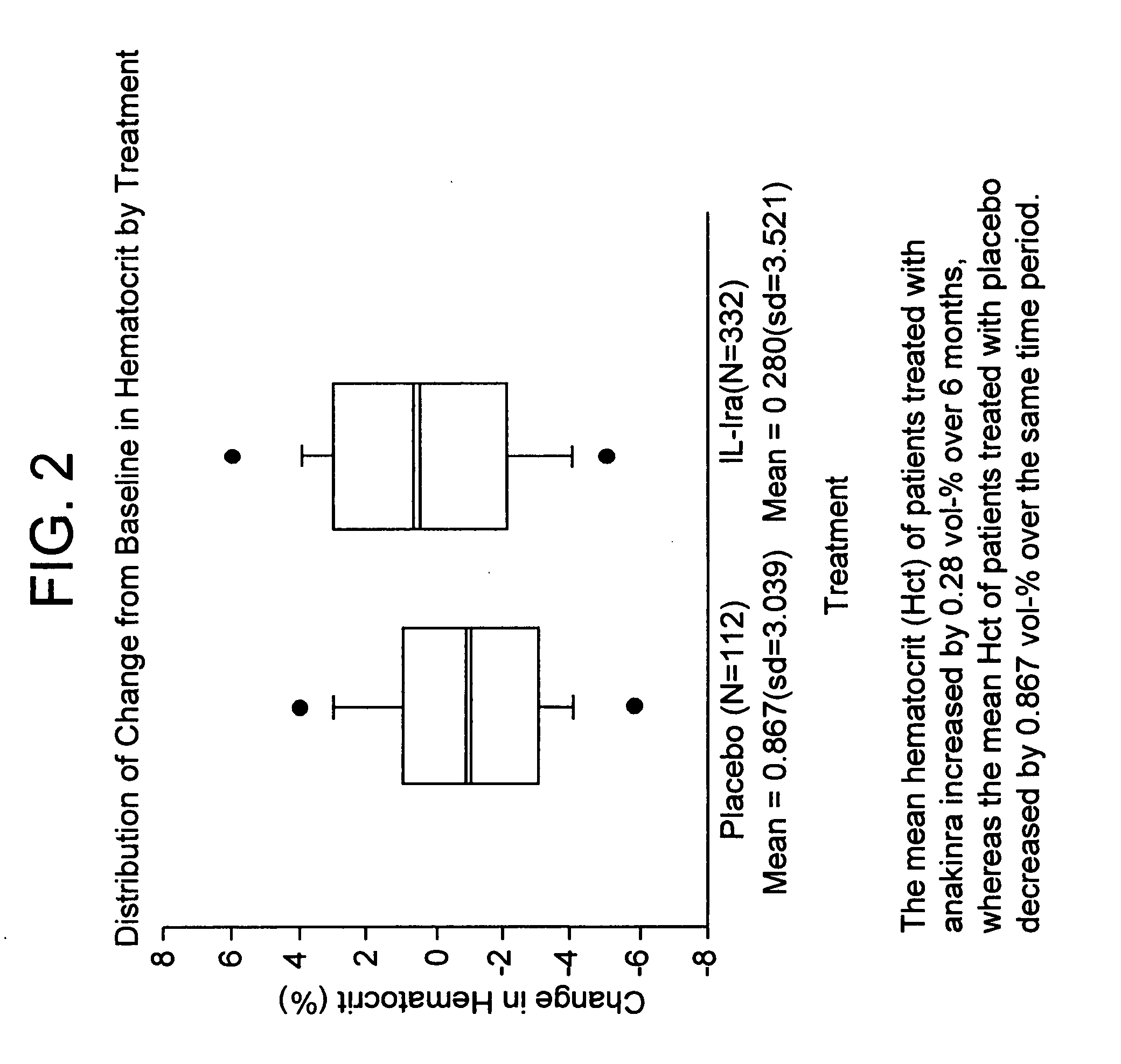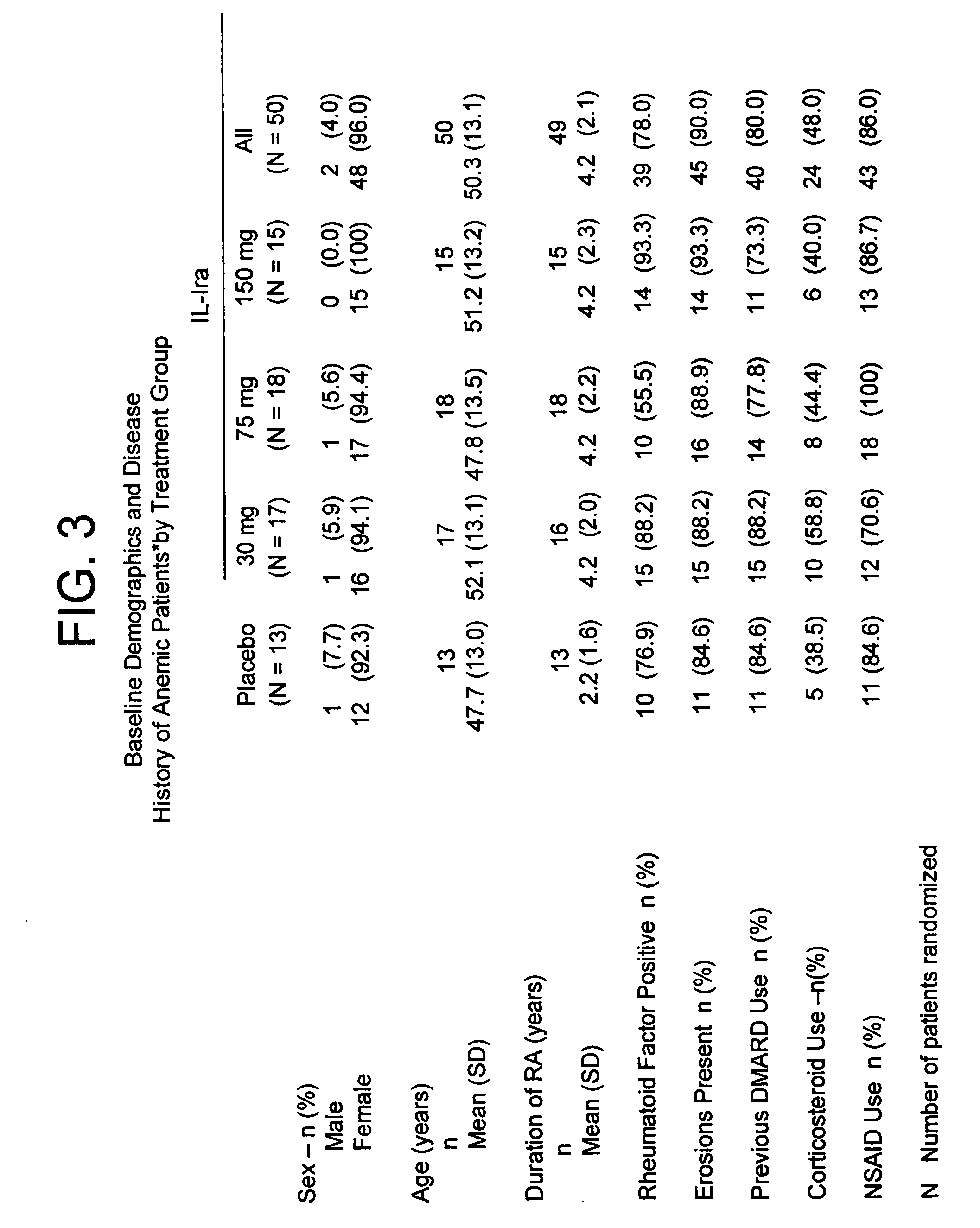Method of treating blood disorders
a blood disorder and blood technology, applied in the field of treating blood disorders, can solve the problems of affecting the immune system, affecting the hematocrit, etc., and achieve the effect of maintaining hematocri
- Summary
- Abstract
- Description
- Claims
- Application Information
AI Technical Summary
Problems solved by technology
Method used
Image
Examples
example 1
Administration of an IL-1ra Analog Increases Hematocrit Levels
[0187] In a multi-center, double-blind, dose-ranging study, subjects with active severe or very severe rheumatoid arthritis (N=472) received daily subcutaneous injections for 6 months of placebo, 30, 75, or 150 mg of a recombinant, non-glycosylated IL-1ra analog (“anakinra”). See FIG. 1 for baseline demographics and disease history by treatment group. Anakinra is a non-glycosylated form of human IL-1ra that is recombinantly made in E. coli.
[0188] Anakinra was injected at concentrations of either 30, 75, or 150 mg / ml of purified anakinra in suspending solution. The suspending solution contained 140 mM sodium chloride, 10 mM sodium citrate, 0.1% (w / w) polysorbate 80, 0.5 mM EDTA, and sterile water for injection. Placebo consisted of the suspending solution. Anakinra and placebo solutions were stored at temperatures between 20 and 80 C. The pH of all solutions was 6.5.
[0189] A total volume of 1 ml was injected each day. P...
example 2
Administration of Anakinra Improves Anemia
[0192] In the study of the effect of anakinra on hematocrit levels described in Example 1, a subset of subjects with rheumatoid arthritis were anemic, as defined as hematocrit level less than or equal to thirty-four percent (Pincus et al., Am. J. Med 89:161, 1990, which is incorporated by reference for any purpose), upon initiation of the study. Fifty (14.2%) of the anakinra-treated subjects and thirteen (10.7%) of the placebo-treated subjects were characterized with this degree of anemia (see FIG. 3 for baseline demographics and disease history).
[0193] Although the number of anemic subjects in this study was small, more patients treated with anakinra exhibited improvement in hematocrit levels after twenty-four weeks of treatment than did subjects receiving the placebo. Anemia improved in patients taking each of the three doses of IL-1ra (see FIG. 4 for results).
example 3
Administration of Anakinra May Improve Anemia Independently of Articular Disease
[0194] In the study of the effect of the administration of anakinra on anemia described in Example 2, three of the seven anakinra-treated patients with greater than or equal to six volume-percentage improvement in hematocrit levels did not meet the ACR20 response criteria (FIGS. 5 and 6). The ACR20 defines a subject as improved if the following criteria are met: >20% decrease from baseline in the number of tender / painful joints; >20% decrease from baseline in the number of swollen joints; and >20% decrease from baseline in 3 of the following 5 criteria: 1) subject assessment of disease activity; 2) investigator assessment of disease activity; 3) subject assessment of pain; 4) disability score from the Health Assessment Questionnaire (HAQ); or 5) C-reactive protein. Thus, IL-1ra therapy may improve anemia in rheumatoid arthritis subjects independently of its effect on articular disease activity.
[0195] W...
PUM
| Property | Measurement | Unit |
|---|---|---|
| molecular weight | aaaaa | aaaaa |
| molecular weight | aaaaa | aaaaa |
| molecular weight | aaaaa | aaaaa |
Abstract
Description
Claims
Application Information
 Login to View More
Login to View More - R&D
- Intellectual Property
- Life Sciences
- Materials
- Tech Scout
- Unparalleled Data Quality
- Higher Quality Content
- 60% Fewer Hallucinations
Browse by: Latest US Patents, China's latest patents, Technical Efficacy Thesaurus, Application Domain, Technology Topic, Popular Technical Reports.
© 2025 PatSnap. All rights reserved.Legal|Privacy policy|Modern Slavery Act Transparency Statement|Sitemap|About US| Contact US: help@patsnap.com



